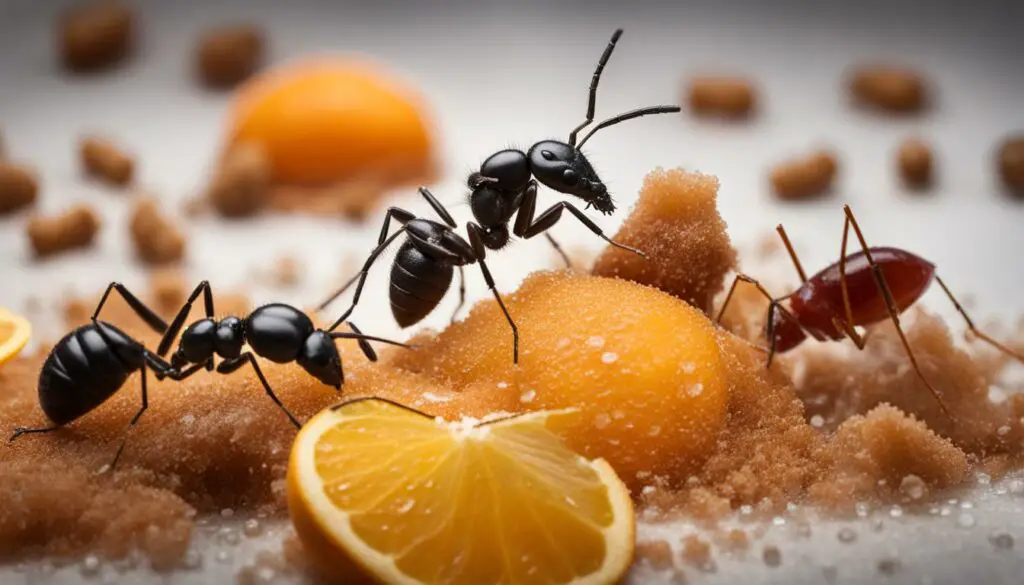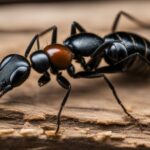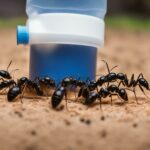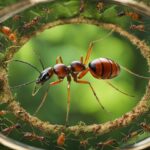Ants can be a nuisance pest, with odorous house ants being the most common species to invade homes. They are small in size but can quickly multiply, making them difficult to eliminate. The use of ant poison alone is not effective in addressing the root cause of an infestation. The key is to identify what is attracting the ants and how they are entering your home. In this article, I will explore five tips from pest-management experts to effectively get rid of ants in your home.
Key Takeaways:
- Understanding the differences between odorous house ants and carpenter ants is crucial for implementing the appropriate prevention methods.
- Cleaning and removing attractants such as food spills and sticky surfaces can help discourage ants from entering your home.
- Using natural repellents like peppermint spray or lavender spray can create a barrier that ants will avoid.
- Vinegar can be used to destroy ant trails and disrupt their communication, deterring them from accessing your home.
- Ant traps can be an effective long-term solution for controlling ant infestations, provided they are placed correctly and given time to work.
Recognizing the Difference Between Odorous House Ants and Carpenter Ants
Odorous house ants and carpenter ants are two common ant species that homeowners may encounter. It is important to be able to differentiate between the two, as they have distinct characteristics and behaviors.
Odorous house ants, also known as sugar ants, are typically small in size, measuring less than 1/8 inch long. They are dark brown to black in color and emit a strong, unpleasant odor when crushed. These ants are commonly found foraging for food in kitchens, bathrooms, and other areas of the house. While they can be a nuisance, odorous house ants do not cause significant damage to the structure of the home or transmit diseases.
Carpenter ants, on the other hand, are larger and range in size from 1/4 to 1/2 inch long. They can be black, red, or a combination of both colors. Carpenter ants are known for their ability to chew through wood and create tunnels for nesting. If left untreated, carpenter ants can cause structural damage to windows, doors, and even the framing of the house. Identifying carpenter ants early on is essential to prevent costly repairs.
| Ant Species | Size | Color | Damage Potential |
|---|---|---|---|
| Odorous House Ants | Less than 1/8 inch | Dark brown to black | Minimal |
| Carpenter Ants | 1/4 to 1/2 inch | Black, red, or combination | Potential structural damage |
By understanding the differences between odorous house ants and carpenter ants, homeowners can implement the appropriate prevention methods and seek professional help if necessary. It is vital to address ant infestations promptly to protect the integrity of the home and ensure a pest-free environment.
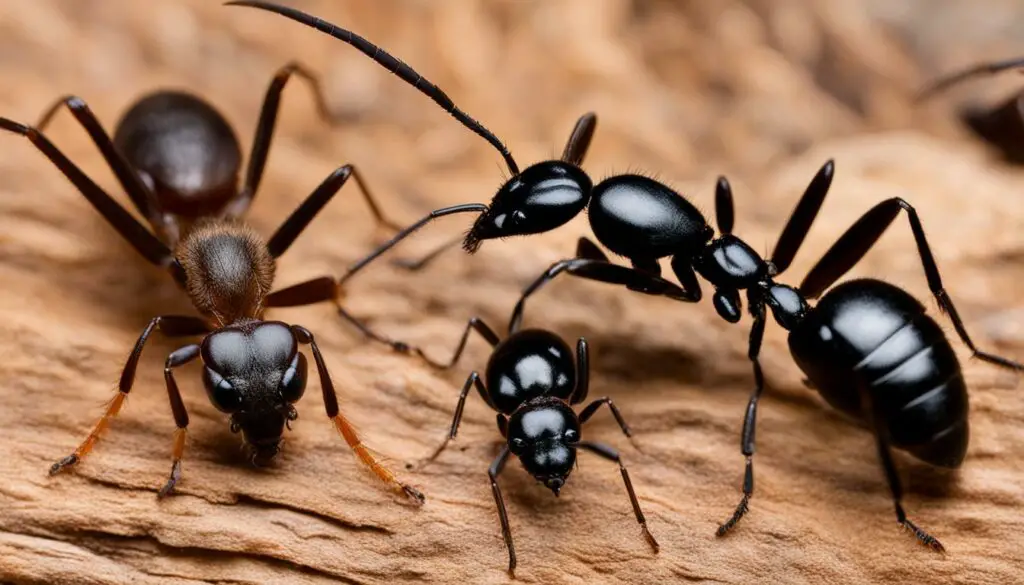
Cleaning and Removing Attractants to Discourage Ants
When it comes to preventing ants from entering your home, one of the first steps is to clean the areas where they are commonly found. Ants are attracted to various food sources, such as sticky residues or food spills. To effectively deter ants, it is essential to eliminate these attractants by cleaning countertops, floors, and other surfaces where crumbs or spills may accumulate.
“Cleaning and Removing Attractants to Discourage Ants.”
“Ants are attracted to food sources, and even the tiniest crumb can become an invitation for them. By regularly cleaning and removing food residues, you can significantly reduce the chances of an ant infestation in your home.”
Identifying and removing potential food sources will help deter ants from entering your home. Additionally, it is important to pay attention to sticky surfaces, such as honey spills or sugary residues. These areas should be thoroughly cleaned to ensure there are no lingering attractants for ants.
| Effective Cleaning Tips to Prevent Ants: |
|---|
| 1. Clean countertops, floors, and other surfaces regularly. |
| 2. Wipe up any food spills immediately. |
| 3. Store food in airtight containers. |
| 4. Dispose of garbage regularly and keep trash cans sealed. |
| 5. Pay attention to sticky surfaces and clean them thoroughly. |
By implementing these cleaning practices, you can significantly reduce the likelihood of attracting ants into your home. Maintaining a clean and hygienic environment will not only prevent ant infestations but also contribute to the overall well-being of your household.
Using Natural Repellents to Keep Ants Away
When it comes to keeping ants out of your home, natural repellents can be a safe and effective solution. These repellents work by utilizing scents that ants dislike, such as peppermint and lavender. Mixing peppermint or lavender oil with water and spraying the mixture on entry points like windowsills or door frames can create a barrier that ants will avoid.
Peppermint spray, in particular, is known for its potent ant-repelling properties. Not only does it help to deter ants, but it also leaves your home smelling fresh and minty. You can easily make your own peppermint spray by combining a few drops of peppermint oil with water in a spray bottle. Spritz it around areas where ants are commonly found, such as near windows or cracks in the walls.
Using natural repellents like peppermint spray and lavender spray is an eco-friendly way to keep ants away from your home.
Lavender spray is another effective option for deterring ants. Like peppermint, ants find the scent of lavender unpleasant. Mix a few drops of lavender oil with water and spray it in areas where ants are likely to enter, such as around baseboards or near outdoor entrances.
Using natural repellents not only helps to keep ants away but can also provide a more environmentally friendly alternative to harsh chemicals. These methods are safe to use around children and pets, making them a great choice for households looking for natural pest control solutions.

Destroying Ant Trails with Vinegar
Ant trails can be a frustrating sight in your home, but there is a simple and effective solution – vinegar. Vinegar is a powerful ant deterrent that disrupts their communication and makes them think twice before coming back. By mixing one part vinegar with three parts water, you can create a solution that will destroy the pheromone trails ants use to navigate.
When you spot ants in your home, simply spray the vinegar solution on the areas where they have been seen. Focus on entry points like windowsills, door frames, and other areas where they may be entering. The strong odor of vinegar will not only disrupt their trails but also masks the scent of any food attractants that may have lured them in the first place.
It’s important to note that vinegar should not be used on surfaces that can be damaged by its acidity, such as marble or granite countertops. However, it is safe to use on most other surfaces and can be a cost-effective and natural solution for deterring ants.
To summarize, here are the steps to follow:
- Mix one part vinegar with three parts water to create a solution.
- Spray the solution on areas where ants have been spotted, focusing on entry points.
- Reapply the solution as needed to ensure the trails are disrupted.
By using vinegar as an ant deterrent, you can effectively disrupt their trails and discourage them from returning to your home.
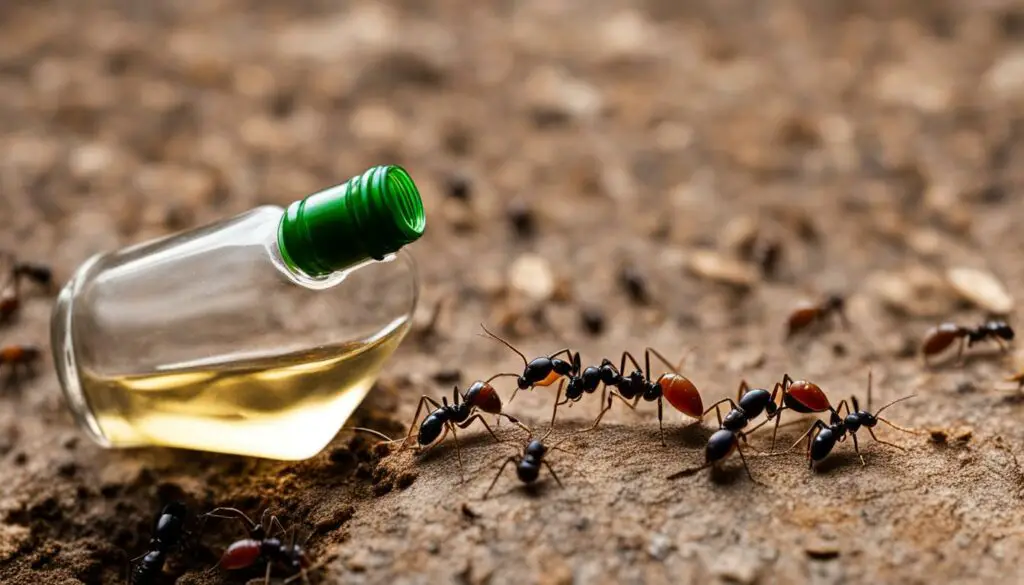
Differentiating Between Odorous House Ants and Carpenter Ants
Before we delve into the method of using vinegar to destroy ant trails, it’s important to understand the different ant species you may encounter. Odorous house ants and carpenter ants are two common invaders in homes, but they have distinct characteristics and potential impacts on your property.
Odorous house ants are smaller in size, typically less than 1/8 inch long. While they can be a nuisance by appearing on kitchen counters or in showers, they do not pose significant structural or health risks. On the other hand, carpenter ants range from 1/4 to 1/2 inch long and have the ability to chew through wood. If left untreated, a carpenter ant infestation can cause damage to windows, doors, and even structural framing.
Understanding the differences between these two ant species is crucial because the prevention methods for each may vary. While vinegar can be effective in disrupting trails and deterring both species, carpenter ant infestations may require additional treatment options to eliminate the colony and prevent further damage.
To summarize:
- Odorous house ants are smaller, while carpenter ants are larger and can cause structural damage.
- Vinegar can be used to deter both species, but further treatment may be needed for carpenter ants.
| Ant Species | Characteristics | Impact |
|---|---|---|
| Odorous House Ants | Small in size, less than 1/8 inch long | Generally a nuisance, do not cause structural damage |
| Carpenter Ants | Larger, ranging from 1/4 to 1/2 inch long | Can chew through wood, potentially causing structural damage |
Using Ant Traps for Effective Long-Term Control
When it comes to dealing with ant infestations, using ant traps can be a highly effective long-term solution. These innovative traps are designed to lure ants with a blend of food they find irresistible, combined with an insecticide. The goal is for the ants to consume the bait and bring it back to their colonies, eliminating the entire ant population.
Proper placement of ant traps is crucial for their effectiveness. By identifying known or suspected activity areas, such as ant trails or entry points, you can strategically position the traps to intercept the ants. Remember to place the traps away from children and pets to avoid accidental contact.
One of the main advantages of using ant traps is their ability to target the entire ant colony. When ants consume the bait and carry it back to their nests, it allows the insecticide to spread, ultimately leading to the elimination of the entire ant colony. This long-term control approach can significantly reduce the chances of future infestations.
| Pros | Cons |
|---|---|
| – Effective in targeting entire ant colonies | – May not be suitable for all ant species |
| – Provides long-term control | – Slow-acting, requiring patience |
| – Easy to use and place | – Some baits may be harmful if consumed by pets or children |
It’s important to note that ant traps may not be suitable for all ant species. Some ant types may not be attracted to the bait or may require alternative control methods. Additionally, ant baits are typically slow-acting, so it’s essential to have patience while waiting for results. If you have concerns about using ant traps, or if your infestation persists despite your efforts, it may be best to seek professional help for a comprehensive ant control solution.

Using Ant Traps for Effective Long-Term Control
One way to effectively control and eliminate ant infestations is by using ant traps. These traps are designed to attract ants with a combination of food and insecticide, ensuring the entire colony is targeted. By placing the traps strategically in known ant activity areas, you can disrupt their population and prevent future infestations. However, it’s important to understand that ant traps may not be suitable for all ant species, and their effectiveness may vary. If you’re unsure or the infestation persists, consulting a pest control professional is recommended.
Seal Entry Points to Prevent Ants from Entering
When it comes to preventing ants from entering your home, one of the most effective strategies is to seal all potential entry points. Ants are incredibly small and can easily find their way through even the tiniest cracks, gaps, or crevices in doors, windows, and walls. By sealing these entry points, you create a physical barrier that ants cannot penetrate, effectively keeping them outside where they belong.
To start, thoroughly inspect your home for any cracks or exposed areas that could serve as entry points for ants. Pay close attention to the areas around doors, windows, utility pipes, and other openings. Use caulk or weatherstripping to seal any gaps or cracks you find. For larger openings, such as gaps between window frames and walls, consider using expanding foam insulation to ensure a tight seal.
In addition to sealing cracks and gaps, it’s also important to address potential entry points that may be present in doors and windows themselves. Install door sweeps or thresholds to prevent ants from sneaking in under doors, and use window screens or sealant strips to keep them out through windows. By taking these simple yet effective measures, you can significantly reduce the likelihood of ants finding their way into your home.
Table: Common Entry Points and How to Seal Them
| Entry Point | Recommended Sealing Method |
|---|---|
| Cracks in walls or foundation | Caulk or weatherstripping |
| Gaps around doors | Door sweeps or thresholds |
| Gaps around windows | Window screens or sealant strips |
| Holes around utility pipes | Expanding foam insulation |
By taking the time to seal all potential entry points, you can greatly reduce the risk of ants making their way into your home. Remember, even the smallest crack or gap can serve as an open invitation to these persistent pests. So be thorough in your inspection and sealing efforts to create an ant-proof barrier that will keep your home pest-free.

Proper Food Storage and Kitchen Cleanup
When it comes to preventing ant infestations, proper food storage and kitchen hygiene are essential. By taking a few simple steps, you can significantly reduce the chances of attracting ants into your home.
First and foremost, make sure to store food properly. Seal items like honey, maple syrup, and sugar in airtight containers or tightly wrapped packaging. This will make it difficult for ants to access these tempting food sources. Additionally, regularly clean out your pantry and cabinets to remove any expired or open food that may attract ants.
Keeping your kitchen clean is equally important. Wipe down countertops, tables, and other surfaces to eliminate crumbs and food residue that ants may be attracted to. It’s also essential to promptly clean up spills and sticky spots, as even the smallest amount of food can be enough to entice ants into your kitchen.
Lastly, don’t forget to take care of your pet’s food and water bowls. Make sure to clean them regularly and store them in an area that is inaccessible to ants. By following these simple practices, you can create an environment that is less appealing to ants and minimize the risk of infestation.

Tips for Proper Food Storage and Kitchen Cleanup:
- Store food in airtight containers or tightly wrapped packaging.
- Clean out your pantry and cabinets regularly to remove expired or open food.
- Wipe down countertops and surfaces to eliminate crumbs and food residue.
- Clean up spills and sticky spots promptly.
- Take care of your pet’s food and water bowls by cleaning them regularly and storing them in ant-proof areas.
Maintaining a Well-Kept Yard to Keep Ants Away
One important aspect of ant prevention is maintaining a well-kept yard. By taking care of your outdoor space, you can significantly reduce the chances of ants finding their way into your home. Here are some key steps to follow:
1. Regular Inspection
Regularly inspect your yard for potential ant habitats. Check along the foundation of your home, tree stumps, wood piles, damaged trees, and outdoor structures. Ants may build their nests in these areas, making it easier for them to access your home. By identifying and removing these ant habitats, you can create a less inviting environment for ants.
2. Prune and Trim
Keep branches, bushes, and shrubs trimmed and away from your house. Overgrown vegetation can provide easy access for ants to enter your home. By maintaining a well-groomed yard, you can create a physical barrier that ants will find difficult to cross.
3. Remove Food Sources
Avoid leaving food or crumbs in your yard, as they can attract ants. Make sure to clean up any outdoor eating areas, such as picnic tables or BBQ grills, and store food in sealed containers. By removing potential food sources, you can discourage ants from foraging in your yard.
| Ant Prevention Tip | Effectiveness |
|---|---|
| Regular Inspection | High |
| Prune and Trim | Medium |
| Remove Food Sources | High |
By following these yard maintenance practices, you can significantly reduce the risk of ant infestations in your home. Remember, prevention is key when it comes to ants, and taking proactive measures in your yard can go a long way in keeping them away.

When to Seek Professional Help for Ant Infestations
If your ant infestation becomes overwhelming or persists despite your DIY efforts, it may be time to seek professional help. Pest control professionals have the expertise to identify the ant species, assess the extent of the infestation, and provide targeted treatment solutions that effectively eliminate ant colonies and prevent future infestations.
Professional pest control offers several advantages over attempting to tackle the problem on your own. Firstly, pest control professionals have in-depth knowledge of ant behavior, allowing them to implement the most appropriate and effective treatment methods. They can accurately identify the ant species and determine the best course of action to eradicate the infestation.
Additionally, pest control professionals have access to specialized equipment and products that are not readily available to homeowners. These tools enable them to reach hidden or hard-to-reach areas where ants may be nesting or accessing your home. By targeting the source of the infestation, professionals can provide comprehensive ant control that eliminates the problem at its root.
Ultimately, seeking professional help for ant infestations can save you time, money, and frustration. With their knowledge, experience, and resources, pest control professionals can provide the most effective and long-lasting solutions, giving you peace of mind and a pest-free home.
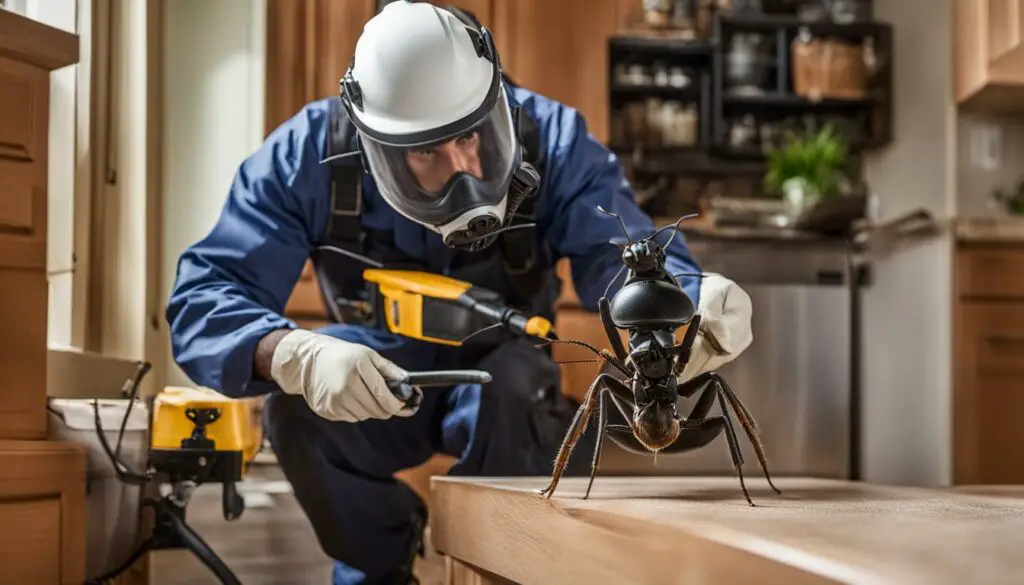
Pros and Cons of Ant Bait Traps
Ant bait traps are a popular option for ant control, but it is important to consider both the pros and cons before using them in your home. These traps work by enticing ants with a food-based bait that contains an insecticide. Once the ants consume the bait, they bring it back to their colony, which helps eliminate the entire ant population. However, there are several factors to consider when deciding if ant bait traps are the right choice for your situation.
The Pros of Ant Bait Traps
- Effective: Ant bait traps can be highly effective in controlling certain species of ants. They target the entire colony, rather than just individual ants, ensuring long-term control.
- Convenience: Ant bait traps are easy to use and require minimal effort. Simply place the traps in areas where ants are active and let the bait do the work.
- Safe: Ant bait traps are generally considered safe to use around pets and children when used according to the instructions. The insecticides used in the bait are often less toxic than traditional pesticide sprays.
The Cons of Ant Bait Traps
- Species Specific: Ant bait traps may not be effective for all species of ants. Some ants have different feeding preferences and may not be attracted to the bait, rendering the traps ineffective.
- Slow-Acting: Ant bait traps take time to work. It can take several days or even weeks before you notice a significant decrease in ant activity. Patience is key when using this method.
- Potential Harm: While ant bait traps are generally safe, it is important to ensure that pets and children cannot access the bait. Some traps may contain ingredients that can be harmful if ingested.
When considering ant control options, it is crucial to weigh the pros and cons to make an informed decision. Ant bait traps can be an effective tool in your ant prevention arsenal, but they may not be suitable for all situations. If you have a severe or persistent ant infestation, it is best to consult a pest control professional for personalized advice and comprehensive ant management strategies.
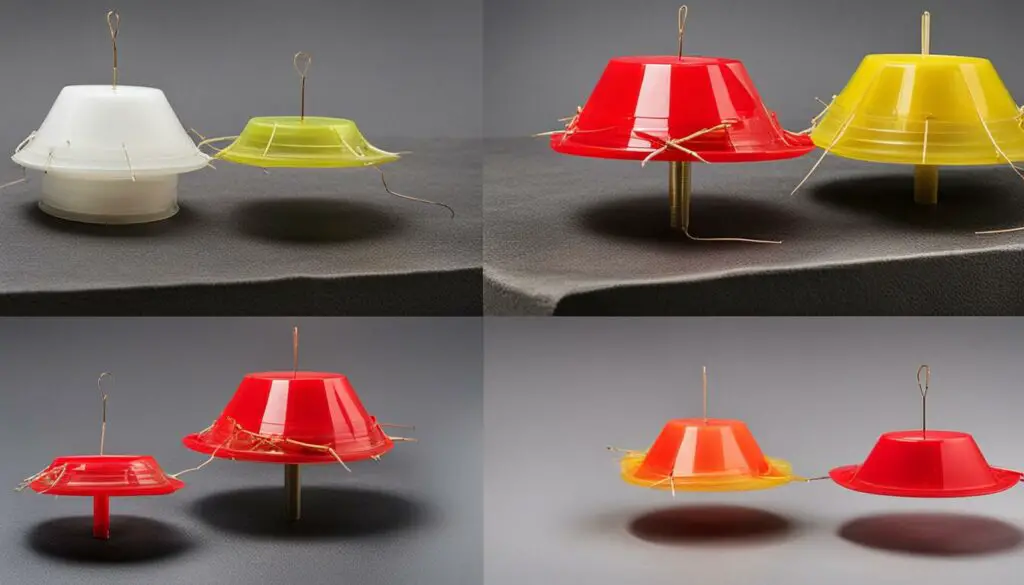
The Importance of Consulting a Pest Control Professional
When it comes to dealing with ant infestations, seeking the expertise of a pest control professional is essential. While DIY methods can be effective to some extent, a comprehensive and long-term solution often requires the knowledge and tools that only a professional can provide. Here, we highlight the key reasons why consulting a pest control professional is crucial for effective ant control.
Accurate Ant Species Identification
In order to implement the most effective treatment plan, it is important to accurately identify the specific ant species causing the infestation. Different ant species have different behaviors and nesting habits, which require tailored approaches for control. A pest control professional can accurately identify the ant species present in your home and determine the most appropriate treatment method.
Comprehensive Ant Control
Pest control professionals have access to a range of specialized equipment and products that are not available to the general public. This enables them to tackle ant infestations at their source and provide comprehensive control measures. From targeted treatments to eliminating ant colonies to sealing entry points, professionals can develop a customized plan to effectively eradicate ants from your home.
Peace of Mind and Long-Term Prevention
By consulting a pest control professional, you can have peace of mind knowing that your ant infestation is being handled by experts. They have the experience and expertise to ensure thorough elimination of ants and can provide you with advice on how to prevent future infestations. This includes recommendations on proper sanitation, effective ant deterrents, and regular inspections to catch any signs of re-infestation early.
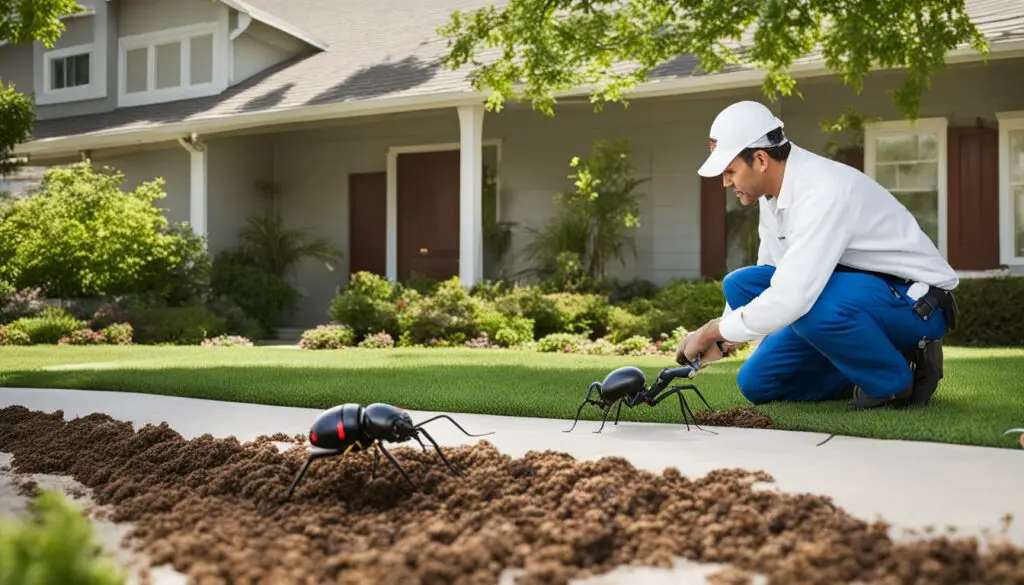
In conclusion, while DIY methods can help in the short term, consulting a pest control professional is crucial for effective and long-term ant control. Their ability to accurately identify ant species, provide comprehensive control measures, and offer prevention strategies ensures a pest-free home. Don’t let ant infestations become a persistent problem – seek the assistance of a pest control professional for optimal results.
Conclusion
In conclusion, implementing effective ant escape prevention methods is essential for maintaining a pest-free environment. By combining cleaning, sealing entry points, using natural repellents, and considering ant traps, homeowners can significantly reduce ant infestations in their homes. These ant eradication strategies are not only practical but also eco-friendly, making them a great choice for those seeking sustainable pest management approaches.
However, it is important to note that for persistent or severe ant infestations, consulting a pest control professional is crucial. They have the expertise to accurately identify ant species and develop comprehensive ant management approaches tailored to the specific infestation. Their specialized treatment options ensure thorough ant control and long-term prevention, giving homeowners peace of mind.
By following the tips and recommendations outlined in this article, individuals can effectively combat ant problems and create a harmonious living space free from these unwanted pests. Remember, early prevention and timely action are key to successful ant eradication, so don’t hesitate to employ these strategies and seek professional help when necessary.
FAQ
What are some effective ant escape prevention methods?
Effective ant escape prevention methods include cleaning and removing attractants, using natural repellents, destroying ant trails with vinegar, using ant traps, sealing entry points, practicing proper food storage and kitchen cleanup, maintaining a well-kept yard, and seeking professional help when needed.
How can I differentiate between odorous house ants and carpenter ants?
Odorous house ants are small in size and typically less than 1/8 inch long. They are common invaders in homes and are often found on kitchen counters or in showers. On the other hand, carpenter ants are larger, ranging from 1/4 to 1/2 inch long. They can chew through rotten or damp wood and potentially cause damage to windows, doors, or structural framing. Proper identification is important to implement the appropriate prevention methods.
What can I do to discourage ants by cleaning and removing attractants?
Cleaning countertops, floors, and other surfaces where crumbs or food spills may accumulate is crucial. By eliminating these food sources, you can deter ants from entering your home.
Are there any natural repellents that can help keep ants away?
Yes, ants dislike scents such as peppermint and lavender. Mixing peppermint or lavender oil with water and spraying the mixture on entry points like windowsills or door frames can create a barrier that ants will avoid. These natural repellents are safe to use and can be an eco-friendly solution for ant prevention.
How can I destroy ant trails with vinegar?
A mixture of one part vinegar to three parts water can be sprayed on areas where ants have been spotted. This solution destroys the pheromone trails that ants use to communicate and navigate, effectively discouraging them from returning to your home.
Are ant traps effective for long-term ant control?
Yes, ant traps can be an effective long-term solution for controlling ant infestations. These traps contain a blend of food that ants find appetizing, combined with an insecticide. The goal is for the ants to consume the bait and take it back to their nests, eliminating the entire colony.
How can I seal entry points to prevent ants from entering my home?
It is crucial to seal any cracks or exposed crevices in doors and windows. Ants can easily find their way through even the smallest openings. By caulking and sealing these entry points, you can create a barrier that ants cannot penetrate, effectively keeping them outside.
What should I do for proper food storage and kitchen cleanup to prevent ant infestations?
It is essential to keep food, especially items like honey, maple syrup, and sugar, in airtight containers or tightly wrapped to make it inaccessible to ants. Regularly cleaning countertops, floors, cabinets, and pantries will remove any crumbs or food residue that may attract ants. Additionally, ensure that pet bowls are cleaned and stored properly to avoid attracting ants.
How can I maintain a well-kept yard to keep ants away?
Regularly inspecting for ant beds along the home’s foundation, tree stumps, wood piles, damaged trees, and outdoor structures is important. Removing these potential ant habitats and keeping branches, bushes, or shrubs away from the house can prevent ants from easily entering your home.
When should I seek professional help for ant infestations?
If an ant infestation becomes overwhelming or persists despite DIY efforts, it may be necessary to seek professional help. Pest control professionals can identify the ant species, determine the extent of the infestation, and provide targeted treatment solutions. Their expertise and specialized tools ensure thorough ant control and long-term prevention.
What are the pros and cons of using ant bait traps?
Ant bait traps can be effective in controlling or deterring certain species of ants. They work by enticing ants to consume the bait, which contains an insecticide, and take it back to their nests to eliminate the entire colony. However, they may not be suitable for all types of ants, and their effectiveness depends on proper placement and bait selection. Ant bait traps also take time to work and may not kill ants immediately. Some ant bait traps may be harmful if consumed by pets or children, so caution should be exercised.
Why is it important to consult a pest control professional for ant infestations?
Identifying the ant species and determining the appropriate treatment method can be challenging for homeowners. Different ant species may require specific treatment approaches, and some infestations may be difficult to reach without specialized equipment. Consulting a pest control professional ensures accurate species identification and a comprehensive plan for ant control tailored to the specific infestation.

